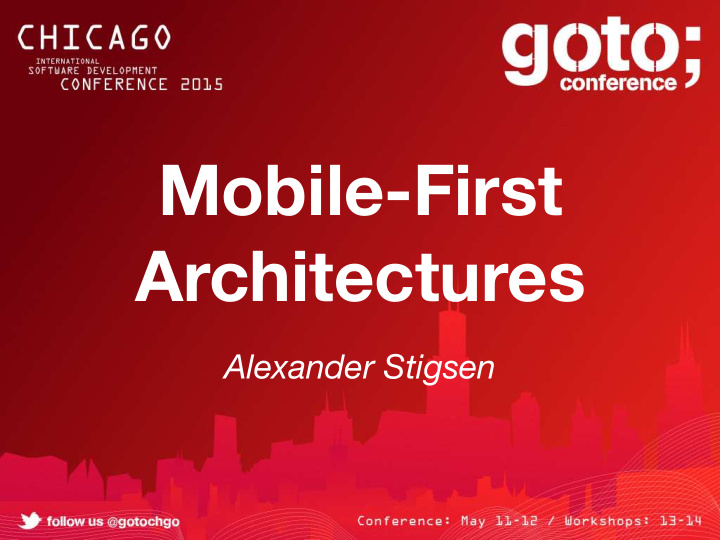



Mobile-First Architectures Alexander Stigsen
Who am I? • Former Mobile Engineer from Nokia • Working on mobile since 1999 Realm • Currently CEO of Realm, building a modern mobile database • Very biased :-)
Problem Mobile Apps are still being build as if they were web apps from the 90s. Realm
Realm
Mobile apps are still treated as dumb clients Realm
Why? • This is how (web) apps have been developed in the last decade. So this is what developers are used to. • Existing API’s are designed with this mindset, so the mobile apps has to conform. • Makes it easier to build both mobile and web versions of the app. Realm
Drawbacks: User Experience Connectivity Tolerance Server Cost Realm
User Experience • Users have much higher expectations of native apps • Apps gets more advanced and capable and as such need more complex data models • No latency or wait times accepted Realm
Connectivity • Users expect apps to always work • The failed promise of ubiquitous connectivity • Even in SF connectivity is spotty • Go to the countryside, still many places with no connectivity • Crises or huge events often takes down connectivity • Developing countries • Next big market • Low connectivity • Expensive data plans Realm
Escalating Server Cost • #1 Killer of startups • App may need millions of users before being able to monetize • Server load scale with number of users • Amazon is expensive! Realm
Problems with the cache approach? • Object access • Can be slow (if they have to get result from server) • Access to un-cached objects will not work when offline • Queries • Will be slow (as they always have to go over the network) • Will not work when offline • Mobile team is dependent on backend team to implement features (slow iterations) Realm
Solution? Realm
Endpoint Computing Realm
Modern phone hardware iPhone 6 1.4 Ghz Dual-core CPU 1 GB memory 16-128 GB storage Quad-core GPU Realm
Use it! • Primary store on phone • User has all his data on the device • Always available • Always instant • Backend is only for coordination, backup and statistics Realm
Server-First cache “smarts” data Realm
Server-First Mobile-First “smarts” cache data “smarts” backup data Realm
Where does this work? From the data perspective, there are fundamentally three kinds of apps: • Single user apps • Collaborative apps • Browser apps Realm
Single user apps All the in the app is owned by and only accessible by a single user (but this user may have multiple devices). Examples: Mint, Expensify, Email apps… Realm
Collaborative apps The user has access to a subset of a larger dataset, where parts are shared with other users. Examples: Slack, Asana, Facebook, Twitter… Realm
Browser apps The user is mostly searching and browsing a larger set of data created by other users. Examples: YouTube, Tinder, Twitter… But could probably still benefit from keeping the non-browsing data local Realm
Mobile Driven Design Change of mindset for developers Start from device, building the best possible experience for the users Then let that shape the backend, rather than the other way around Realm
How does this affect your backend API? Mostly One-way: Examples: email, facebook timeline, twitter stream • Probably not much change needed. • Retrieve list of changes since last update Two-way sync Examples: collaboration, games, todo lists… • Much harder to implement (especially the offline case) • Need to handle conflicts Call to action: we need much better synchronization tools Realm
Is this always the right choice? Primarily for apps that are user-centric (which most are). Not for apps that just browse other peoples data Realm
Benefits of Endpoint Computing • Much more responsive apps • Works even with weak or spotty connectivity • Huge reduction of server load • Mobile team can iterate much faster Realm
The Next Frontier • Live Collaboration • Internet of Things • Virtual Reality • Wearables • Drones Realm
Questions? Please remember to evaluate via the GOTO Guide App
Recommend
More recommend